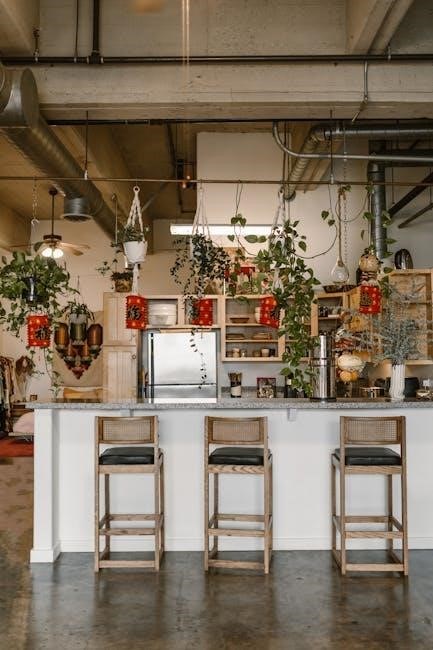Choosing the right counter stool height is crucial for comfort, functionality, and aesthetics․ This guide helps you understand the importance of proper stool height for your space, ensuring a perfect balance between comfort and style while enhancing your home’s decor․ Learn how to measure, select, and arrange stools for optimal use․
Importance of Choosing the Right Stool Height
Choosing the right stool height is essential for comfort, ergonomics, and functionality․ Incorrect heights can lead to discomfort, poor posture, or difficulty moving around the counter․ Proper stool height ensures users can sit comfortably with their feet flat or on a footrest, elbows at a 90-degree angle, and adequate space between the seat and counter․ This balance enhances usability and aesthetic harmony․ Measuring accurately and understanding standard heights (24-27 inches for counters, 28-32 inches for bars) helps avoid common mistakes․ The ideal stool height creates a seamless integration into your space, ensuring both practicality and style․
Overview of Counter and Bar Stool Heights
Counter stools and bar stools differ in height to accommodate various spaces and purposes․ Counter stools typically range from 24 to 27 inches, designed for standard kitchen counters or high tables․ Bar stools are taller, usually between 28 and 32 inches, to fit bar counters or elevated surfaces․ Spectator stools, a taller option at 33-36 inches, are ideal for transitional spaces․ Understanding these height categories helps in selecting stools that align with your furniture and ensure a comfortable seating arrangement․ Proper height selection enhances functionality and harmony in any setting, whether casual or formal․
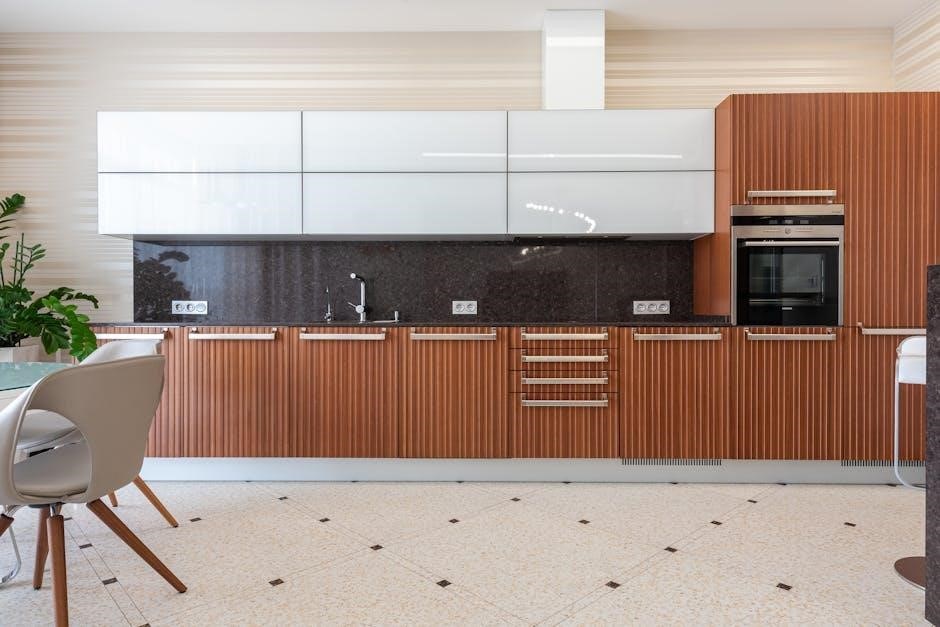
Understanding Counter Stool Heights
Counter stools typically range from 24 to 27 inches tall, designed to pair with standard kitchen counters or high tables․ Their compact design ensures comfort and functionality, making them ideal for everyday use in casual dining or food preparation settings․ Understanding these dimensions helps in selecting stools that align with your space, ensuring a seamless integration of style and practicality․ Proper height selection enhances both comfort and aesthetic appeal in various home environments․
What Are Counter Height Stools?
Counter height stools are designed to complement standard kitchen counters, typically measuring 36 inches in height․ These stools usually have seat heights ranging from 24 to 27 inches, making them ideal for casual dining, food preparation, or socializing․ They are versatile and can be used in various settings, including breakfast bars, high tables, or island counters․ Counter stools are a popular choice for their balance of comfort and practicality, offering a relaxed seating option while maintaining a stylish aesthetic that blends seamlessly with modern or traditional interiors․
Standard Dimensions for Counter Stools
Counter stools typically have a seat height of 24 to 27 inches, designed to align with standard kitchen counters that are usually 36 inches tall․ The overall height, including the backrest, may range from 30 to 34 inches․ These dimensions ensure comfort and functionality, allowing users to sit with their elbows at counter height․ The width and depth of counter stools vary by design, but they generally fit neatly under counters for space efficiency․ Understanding these standards helps in selecting stools that complement your space while maintaining ergonomic comfort and aesthetic appeal․
Bar Stool Heights Explained
Bar stools are taller than counter stools, typically ranging from 28 to 32 inches in seat height, designed for use with higher surfaces like bar counters or pub tables․ They offer a comfortable seating option for socializing and dining in elevated spaces, while spectator stools can be even taller, at 33-36 inches, for overseeing activities․ This height range ensures versatility and adaptability to various settings, making bar stools a practical choice for both functionality and style․
Differences Between Counter and Bar Stools
Counter stools and bar stools differ primarily in height and design․ Counter stools typically range from 24 to 27 inches in seat height, making them ideal for standard kitchen counters (around 36 inches tall)․ Bar stools are taller, with seat heights between 28 and 32 inches, designed for use with bar counters or high tables (usually 40-42 inches tall)․ While counter stools are more compact and often used for casual dining, bar stools are designed for socializing and may feature additional comfort elements like backs or armrests․ Understanding these distinctions ensures the right choice for your space and needs․
Standard Bar Stool Dimensions
Standard bar stools typically have a seat height of 28 to 32 inches, designed to complement bar counters or high tables (usually 40-42 inches tall)․ The overall height, including the backrest, can range from 40 to 45 inches․ Width and depth generally range between 17 to 22 inches, ensuring stability and comfort․ These dimensions provide ample legroom and a comfortable seating position for socializing or dining․ Variations may exist, with spectator stools being taller (33-36 inches) for specific needs․ Always consider the table or counter height when selecting bar stools for optimal functionality and aesthetics․

How to Measure for the Perfect Stool Height
Measure your counter or table height from the floor to the surface․ Ensure 9-13 inches between the seat and countertop for comfort and proper fit․
Measuring Your Counter or Table Height
To determine the ideal stool height, start by measuring your counter or table height from the floor to the surface․ Use a tape measure for accuracy․ Ensure the measurement accounts for any overhang or lip on the countertop․ Record the height to reference later when selecting stools․ This step is crucial for ensuring comfort and proper fit․ For example, a 36-inch counter typically pairs with 24-27 inch stools, while a taller bar counter (about 42 inches) requires 28-32 inch stools․ Accurate measurements prevent discomfort and ensure optimal seating․ Avoid guessing to achieve the best results․
Calculating the Ideal Seat Height
To find the perfect stool height, measure your counter or table height and subtract 9-13 inches for comfort․ For a standard 36-inch counter, stools between 24-27 inches work best․ For taller bars (42 inches), stools should be 28-32 inches․ Ensure the seat height allows a 9-13 inch gap between the stool and counter for comfortable seating․ This calculation ensures optimal ergonomics and prevents discomfort․ Proper measurement and calculation are key to selecting stools that fit seamlessly with your space and provide long-term comfort for users․ Always consider personal comfort and table height when finalizing your choice․
Factors Influencing Stool Height Selection
Counter type, height variations, and personal comfort significantly impact stool height choice․ Measure your space and consider ergonomic needs to ensure optimal seating solutions․
Counter Type and Height Variations

Counter type and height significantly influence stool selection․ Standard counters are typically 36 inches tall, requiring stools with 24-27 inch seat heights․ Raised counters or bars may need taller stools, while lower counters demand shorter ones․ Measure your counter height accurately to determine the ideal stool size․ Consider variations in counter styles, such as kitchen islands or breakfast bars, which may have different heights․ Ensuring a 9-13 inch gap between the stool seat and counter is crucial for comfort and functionality․ Adapt your stool choice to fit your space perfectly for an ergonomic and visually appealing setup․
Personal Comfort and Ergonomic Considerations
Personal comfort and ergonomics play a vital role in selecting the right stool height․ Ensure the stool seat allows a 9-13 inch gap between it and the counter for comfortable seating․ Look for stools with back support or armrests to enhance posture and reduce strain․ Cushioning and seat depth also matter for long-term comfort․ Consider adjustable stools for flexibility, as they can accommodate different users and settings․ Prioritize materials that promote breathability and durability․ Proper ergonomic design ensures users can sit comfortably without slouching, making stools suitable for both short and extended periods of use․
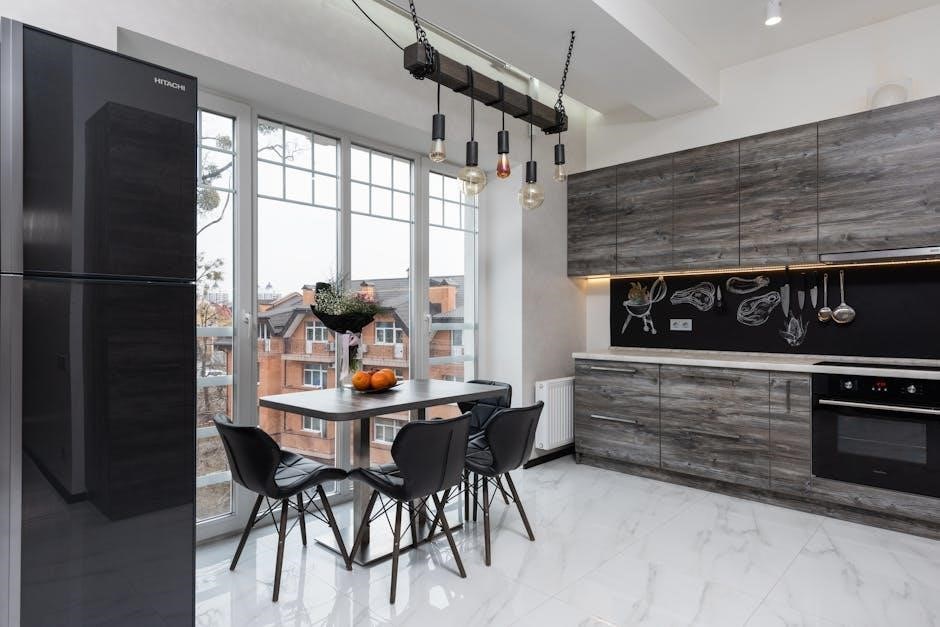
Common Stool Height Standards
Common stool heights are designed to fit various spaces, ensuring comfort and functionality․ Understanding these standards helps in selecting the perfect stools for your needs․
Counter Stool Height Range (24-27 Inches)
Counter stools typically feature a seat height of 24 to 27 inches, making them ideal for standard kitchen counters that are usually around 36 inches tall․ This range provides comfortable seating for casual meals, food preparation, or socializing․ The 24-27 inch height ensures that users can sit with their elbows at a 90-degree angle to the counter, promoting ergonomic comfort․ This size is perfect for everyday use and blends seamlessly into most home decors, offering both practicality and style for various spaces․ It’s a popular choice for those seeking a balance between functionality and aesthetic appeal․
Bar Stool Height Range (28-32 Inches)
Bar stools typically range from 28 to 32 inches in seat height, designed for higher surfaces like bar counters or tall tables․ This height provides ample legroom, ensuring comfort and ergonomic positioning․ Ideal for social spaces, they often feature backless designs or swivel mechanisms for convenience․ When choosing, consider the material and style to match your decor, ensuring durability and aesthetic appeal․ This range is perfect for creating a cozy yet functional atmosphere in any setting․
Specialized Stool Heights
Spectator stools, with heights of 33-36 inches, cater to higher surfaces like pub tables, offering a unique seating option for socializing and comfort in elevated spaces․
Spectator Stools (33-36 Inches)
Spectator stools, ranging from 33 to 36 inches in height, are designed for elevated surfaces like pub tables or high bars, providing a comfortable perch for socializing․ Their taller design allows users to engage easily with others while seated, making them ideal for entertainment areas or game rooms․ These stools often feature ergonomic designs and stylish accents, blending functionality with aesthetic appeal․ When choosing spectator stools, consider the height of the surface they’ll be used with and ensure adequate legroom for comfort․ They’re a great option for creating a welcoming atmosphere in modern spaces․

Adjustable Stools and Their Benefits
Adjustable stools offer unparalleled versatility, allowing users to customize seat heights to suit various needs and settings․ These stools are ideal for multi-use spaces, as their height can be tailored to fit different tables, counters, or bars․ One of their key benefits is the ability to accommodate multiple users with varying preferences or requirements․ Many adjustable stools feature ergonomic designs, ensuring comfort and proper posture․ They are also easy to adapt for both children and adults, making them a practical choice for dynamic households․ This flexibility enhances functionality while maintaining a sleek, modern aesthetic in any room․ Their ease of use and durability further solidify their appeal as a practical and stylish seating solution․

Material and Style Considerations
Material and style significantly impact stool height choice, affecting durability, aesthetics, and comfort․ Wood, metal, and plastic options vary in weight, look, and longevity, while styles like modern or rustic enhance space decor, ensuring a balance between form and function․
How Material Affects Stool Height Choice
Material plays a crucial role in determining stool height suitability․ Heavier materials like wood or metal may require lower stools for stability, while lighter options like plastic offer more height flexibility․ Durable materials often support taller stools, ensuring long-term comfort and structural integrity․ Additionally, the aesthetic appeal of materials like leather or fabric can influence height choices to match interior designs․ Understanding how materials impact both functionality and style helps in selecting stools that blend seamlessly with your space while maintaining optimal height for comfort and practicality․
Style Matching for Your Space
Stool style should complement your space’s aesthetic to create a cohesive look․ Modern stools with sleek designs suit contemporary interiors, while rustic or vintage styles enhance traditional settings․ Consider materials and finishes that align with your decor, such as metal for industrial spaces or wood for cozy environments․ Color and upholstery also play a role in blending stools with your room’s theme․ Ensure the style reflects your personal taste while maintaining functionality and comfort․ Balancing aesthetics with practicality ensures your stools enhance both the look and usability of your kitchen or bar area․
Spacing and Arrangement Tips
Proper spacing between stools ensures comfort and accessibility․ Aim for 6-8 inches between stools and 12 inches from the counter․ Consider your room’s layout for optimal arrangement․
Optimal Spacing Between Stools
Proper spacing between stools is essential for comfort and accessibility․ Aim for 6-8 inches between adjacent stools to allow easy movement․ For stools placed around a table or counter, ensure there’s at least 12 inches of clearance from the edge of the surface to the stool seat․ Consider the number of stools and the overall layout to avoid overcrowding․ For larger spaces, spacing can be slightly increased, but maintaining a minimum of 6 inches between stools is recommended for a balanced setup․ Proper spacing enhances both functionality and aesthetics, ensuring a comfortable seating arrangement for all users․
Arrangement Ideas for Different Layouts
When arranging stools, consider your space’s layout to maximize comfort and functionality․ For linear counters, place stools evenly spaced, facing forward․ In L-shaped or corner layouts, position stools at 45-degree angles for better conversation flow․ Circular or curved counters benefit from alternating stool angles to encourage interaction․ Always ensure stools align with the counter edge for proper posture․ For small spaces, pair two stools; for larger areas, three or more can work․ Maintain consistent spacing and alignment to create a cohesive, inviting seating area that complements your home’s design․
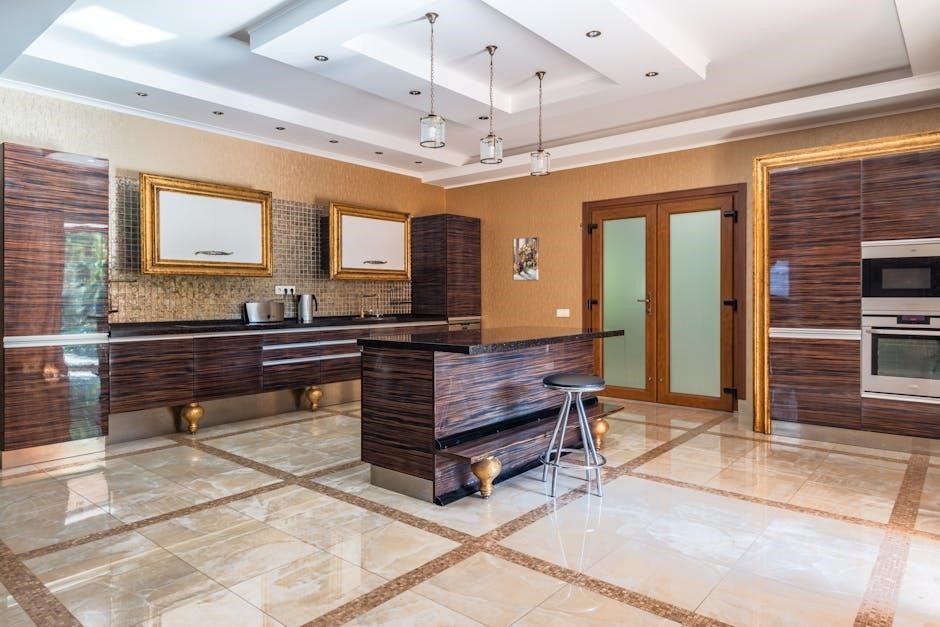
Buying Guide for Counter Stools
Measure your space, consider materials, and check reviews to ensure stools fit your needs․ Look for durability, comfort, and style to enhance your home decor seamlessly․
Key Features to Look For
When selecting counter stools, prioritize seat height, ensuring it matches your counter’s height for comfort․ Consider materials like wood, metal, or plastic for durability and style․ Cushioning and upholstery enhance comfort, while back support and armrests improve ergonomics․ A sturdy base ensures stability, and adjustable features add versatility․ Check for weight capacity and ease of assembly․ Style should complement your space, whether modern, rustic, or minimalist․ Look for reviews and warranties to ensure quality and longevity․ Proper spacing and arrangement are also crucial for a seamless integration into your kitchen or bar area․
Top Brands and Their Offerings
Prominent brands like IKEA, West Elm, and Crate & Barrel offer high-quality counter stools with diverse designs․ IKEA provides affordable, minimalist options, while West Elm focuses on modern aesthetics with ergonomic features․ Crate & Barrel offers sleek, sophisticated stools that blend with contemporary decor․ Other notable brands include Target, offering budget-friendly options, and Pottery Barn, known for sturdy, classic designs․ These brands cater to various styles and preferences, ensuring durability and comfort․ Their collections often feature adjustable heights, cushioned seats, and trendy materials, making it easier to find stools that match your space and needs․

Common Mistakes to Avoid
Common errors include ignoring the recommended seat-to-counter height gap and not considering personal comfort․ These oversights can lead to discomfort and functional issues in daily use․
Incorrect Measurements
One of the most common mistakes is inaccurate measurement of the counter or table height․ Forgetting to account for the space needed between the stool seat and the counter can lead to discomfort․ Many individuals also overlook the importance of measuring multiple times to ensure precision․ Additionally, not considering the average ergonomic guidelines, such as the recommended 9-13 inches between the seat and counter, can result in stools that are too high or too low․ Always double-check measurements to avoid poor fit and functionality issues in your space․
Ignoring Comfort and Ergonomics
Overlooking comfort and ergonomic considerations can lead to discomfort and poor posture․ A stool that is too high or too low forces users into an unnatural position, straining the back and legs․ Many people prioritize style over functionality, neglecting the importance of a seat height that allows feet to rest flat or on a footrest․ The recommended 9-13 inches between the stool seat and counter is often ignored, resulting in a lack of support and long-term discomfort․ Prioritizing ergonomics ensures a more enjoyable and healthier seating experience for everyone using the stools․
Frequently Asked Questions
What is the standard counter height? Most counters are 36 inches tall․ How much space should be between the seat and counter? Aim for 9-13 inches for comfort and ergonomics․
What Is the Standard Counter Height?
The standard counter height typically ranges between 34 and 36 inches from the floor․ This measurement ensures adequate clearance for seating and ergonomic comfort․ Counter stools, designed to pair with these heights, usually have seat heights between 24 and 27 inches, allowing a 9-13 inch gap between the stool seat and the counter surface․ This gap is crucial for comfortable seating and easy movement․ Understanding this standard helps in selecting the right stool height for your space, ensuring both functionality and aesthetic harmony in your kitchen or dining area․
How Much Space Should Be Between the Seat and Counter?
The ideal space between the stool seat and the counter is 9 to 13 inches․ This range ensures comfortable seating while maintaining functionality․ Proper clearance prevents the legs from being too cramped or overly stretched, promoting ergonomic posture․ Measure from the top of the counter to the stool seat to achieve this gap․ Ensuring this space is key for a balanced and practical setup, enhancing both comfort and usability in your kitchen or dining area․
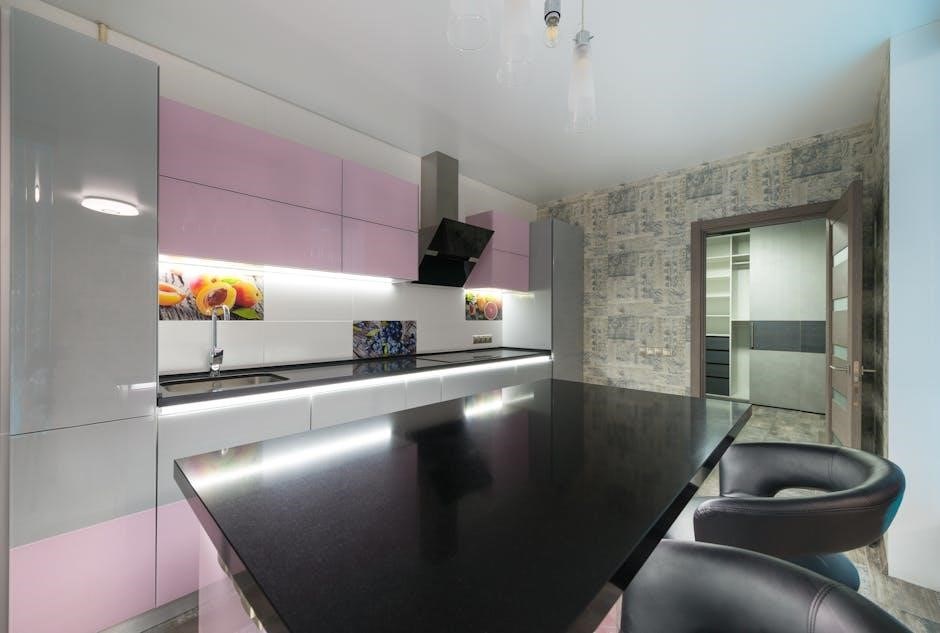
Choosing the right stool height balances comfort, functionality, and style․ Always measure your counter, leave 9-13 inches between the seat and surface, and consider personal ergonomic needs for optimal seating․
Understanding counter stool heights is essential for comfort and functionality․ Measure your counter height accurately, leaving 9-13 inches between the seat and surface․ Counter stools typically range from 24-27 inches, while bar stools are 28-32 inches․ Consider ergonomic needs, personal comfort, and space layout․ Proper spacing between stools ensures a cohesive design․ Always prioritize practicality and style to create a harmonious seating arrangement that enhances your home decor and usability․
Final Thoughts on Choosing the Right Stool Height
Selecting the ideal stool height is a balance of comfort, functionality, and style․ Always measure your counter or table height and leave 9-13 inches for legroom․ Counter stools (24-27 inches) and bar stools (28-32 inches) cater to different spaces․ Prioritize ergonomic design and personal comfort to ensure long-term satisfaction․ Proper spacing and arrangement enhance both aesthetics and usability․ By following these guidelines, you can create a harmonious and functional seating area that complements your home decor while providing optimal comfort for everyday use or entertaining guests․
Additional Resources
Explore recommended guides, measurement tools, and expert tips to further assist in selecting the perfect stool height for your space, ensuring optimal comfort and style․
Recommended Reading
For a deeper understanding, explore guides like “The Ultimate Bar Stool Height Guide” and “Counter Stool Dimensions Explained․” These resources offer insights into measuring techniques, ergonomic considerations, and style matching․ Discover how to optimize stool placement with “Spacing and Arrangement Tips” and learn about material influences on height choices․ E-papers on distributed work and quantum marketing provide additional perspectives on functionality and design․ These readings ensure you’re well-informed to make the best choices for your space, blending comfort, aesthetics, and practicality seamlessly․
Useful Tools for Measurement and Selection
Utilize a measuring tape to accurately determine your counter or table height․ Online stool height calculators can help estimate the ideal seat height based on your space․ Apps like room planners and AR furniture visualizers allow you to preview how stools will fit․ Checklists for key features, such as adjustability and material, ensure you don’t overlook important details․ These tools streamline the selection process, helping you make informed decisions and achieve the perfect balance of comfort, functionality, and style in your home or bar setup․
